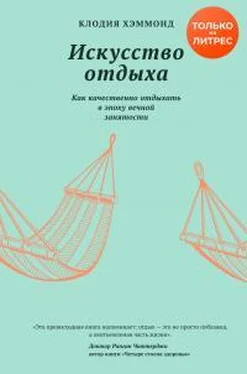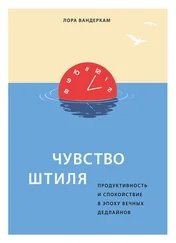120
Sonnentag, S. & Zijlstra, F.R.H. (2006) ‘Job Characteristics and Off-job Activities as Predictors of Need for Recovery, Well-being, and Fatigue’. Journal of Applied Psychology, 91, 330–50
Вернуться
121
Jacobson, E. (1979) ‘Some Highlights of My Life’. Journal of Behavior Therapy & Experimental Psychiatry, 10, 5–9
Вернуться
122
Jacobson, E. (1977) ‘The Origins and Development of Progressive Relaxation’. Journal of Behavior Therapy & Experimental Psychiatry,
Вернуться
123
Nathoo, A. (2016) ‘From Therapeutic Relaxation to Mindfulness wentieth Century’. In Callard, F. et al (Eds) The Restless Compendium. London: Palgrave Pivot
Вернуться
124
Wilson, T. et al (2014) ‘Just Think: The Challenges of the Disengaged Mind’. Science, 345, 75–7
Вернуться
125
Stiles, A. (2012) ‘The Rest Cure, 1873–1925’. Branch, 10. http://www.branchcollective.org/?ps_articles=anne-stiles-the-restcure‐1873–1925
Вернуться
126
Chin, A. et al (2017) ‘Bored in the USA – Experience Sampling and Boredom in Everyday Life’. Emotion, 17 (2), 359–68
Вернуться
127
Mann, S. (2016) The Upside of Downtime: Why Boredom Is Good. London: Robinson
Вернуться
128
Cowan, N. et al (2004) ‘Verbal Recall in Amnesiacs Under Conditions of Diminished Retroactive Interference’. Brain, 127, 825–34
Вернуться
129
Вы могли подумать, что некоторые участники могли повторять слова про себя во время перерывов, но Дюэр так просто не обхитрить. Она заставляла участников запоминать слова на других языках, причем именно сложнопроизносимые. Это не позволяло им проговаривать слова вслух, чтобы лучше их запомнить. Таким образом была получена демонстрация того, что слова лучше вспоминаются, если ничего не делать.
Вернуться
130
Решение: все хорошо, что хорошо кончается; лучше синица в руке, чем жаворонок в небе.
Вернуться
131
От слов life – жизнь и admin – администратор. (Прим. ред.)
Вернуться
132
Crivelli, F. et al (2016) ‘Somnomat: A Novel Actuated Bed to Investigate the Effect of Vestibular Stimulation’. Medical & Biological Engineering & Computing, 54 (6), 877–89
Вернуться
133
Smith, R.P. (1958) How to Do Nothing with Nobody All Alone by Yourself. New York: Tin House Books. There’s also a lovely summary on Brainpickings, 24 10 2014. https://www.brainpickings.org/2014/10/24/how-to-do-nothing-with-nobody-all-alone-by-yourself/
Вернуться
134
Книга не выходила на русском, однако переводится это примерно так – «Как не делать ничего в одиночестве, в абсолютном уединении и полном безлюдье» (Прим. пер.) .
Вернуться
135
Rhodes, J. (2015) Instrumental, Edinburgh: Canongate, 204
Вернуться
136
Sack, K. (1998) ‘Georgia’s Governor Seeks Musical Start for Babies’. New York Times, 15 01 1998
Вернуться
137
Rauscher, F.H. et al (1993) ‘Music and Spatial Task Performance’. Nature, 365, 611
Вернуться
138
Chabris, C.F. (1999) ‘Prelude or Requiem for the “Mozart Effect”?’. Nature, 400, 826–7
Вернуться
139
Schellenberg, E. et al (2006) ‘Music Listening and Cognitive Abilities in 10 and 11 Year-olds: The Blur Effect’. Annals of the New York Academy of Sciences, 1060, 202–9
Вернуться
140
Pietchnig, J. et al (2010) ‘Mozart Effect – Schmozart Effect: A Meta-analysis’. Intelligence, 38, 314–23
Вернуться
141
Nantais, K.M. & Schellenberg, E.G. (1999) ‘The Mozart Effect: An Artefact of Preference’. Psychological Science,10 (4), 370–3
Вернуться
142
Trahan, T. et al (2018) ‘The Music that Helps People Sleep and the Reasons They Believe it Works’. PLOS One, 13 (11) e0206531. doi:10.1371/journal.pone.0206531
Вернуться
143
Saarikallio, S. & Erkkila, J. (2007) ‘The Role of Music in Adolescents’ Mood Regulation’. Psychology of Music, 35 (1), 88–109
Вернуться
144
Konečni, V. et al (1976) ‘Anger and Expression of Aggression: Effects on Aesthetic Preferences’. Scientific Aesthetics, 1, 47–55
Вернуться
145
North, A.C. & Hargreaves, D.J. (2000) ‘Musical Preferences During and After Relaxation and Exercise’. American Journal of Psychology, 113, 43–67
Вернуться
146
Bruner, G.C. (1990) ‘Music, Mood and Marketing’. Journal of Marketing, 54 (4) 94–104
Вернуться
147
Juslin, P. et al (2008) ‘An Experience Sampling Study of Emotional Reactions to Music: Listener, Music and Situation’. Emotion, 8 (5), 668–83
Вернуться
148
Linneman, A. et al (2015) ‘Music Listening as a Means of Stress Reduction in Daily Life’. Psychoneuroendocrinology, 60, 82–90
Вернуться
149
Summers, P. (2018) The Spirit of This Place: How Music Illuminates the Human Spirit. Chicago: University of Chicago Press, 70
Вернуться
150
Garrido, S. et al (2017) ‘Group Rumination: Social Interactions Around Music in People with Depression’. Frontiers in Psychology, 8, 490
Вернуться
151
Summers, P. (2018) The Spirit of This Place: How Music Illumin ates the Human Spirit. Chicago: University of Chicago Press, 150
Вернуться
152
Byrne, D. (2012) How Music Works. Edinburgh: Canongate, 137 & 332
Вернуться
153
Wilkinson, R. & Pickett, K. (2018) The Inner Level. London: Allen Lane, 117
Вернуться
154
Hawkley, L.C. & Cacioppo, J.T. (2010) ‘Loneliness Matters: A Theoretical and Empirical Review of Consequences and Mechanisms’. Annals of Behavioral Medicine, 40 (2), 218–27
Вернуться
155
Colette (1974) Earthly Paradise. London: Penguin.
Вернуться
156
Larson R. W. et al (1982) ‘Time Alone in Daily Experience: Loneliness or Renewal?’. In Peplau, L.A. & Perlman, D. (Eds) Loneliness: A Sourcebook of Current Theory, Research and Therapy. New York: Wiley
Вернуться
157
Matias, G.P. et al (2011) ‘Solitude and Cortisol: Associations with State and Trait Affect in Daily Life’. Biological Psychology, 86, 314–19
Вернуться
158
Long, C.R. & Averill, J.R. (2003) ‘Solitude: An Exploration of the Benefits of Being Alone’. Journal for the Theory of Social Behavior, 33 (1), 21–44
Читать дальше
Конец ознакомительного отрывка
Купить книгу












